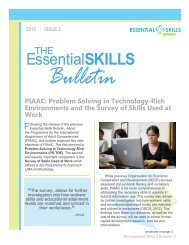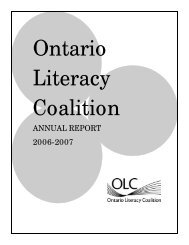Uncharted Territory - Essential Skills Ontario
Uncharted Territory - Essential Skills Ontario
Uncharted Territory - Essential Skills Ontario
Create successful ePaper yourself
Turn your PDF publications into a flip-book with our unique Google optimized e-Paper software.
THE PROCESSES OF SOCIAL INNOVATION• Budgetary constraints, rising costs and lack of resources for newprogramming: In the context of government deficit reduction, civil servantsare under increasing pressure to effectively allocate resources to ensure thatsociety has the services and resources to succeed, yet allow industry toremain competitive. The costs of an aging society, pension liabilities,decreasing tax revenues and other social issues threaten to hamper publicspending in the foreseeable future.• An era of change: Much of what is currently taken for granted in socialpolicy and service delivery began as promising ideas and unproven practicesin the 1940’s. For the next 60 years, government was viewed as the primaryor sole “problem-solver” of social issues through public policy discourse orfunding. Over the past decade, policy experts have come to understand thatthese problems may require solutions beyond the traditional ones. There isan increasing sense that we have reached a tipping point towards a newparadigm of shared responsibility. Most governments, non-profits, and evenmany businesses, understand that they need to move beyond isolated rolesand dynamics to find new ways of creating social well-being. This concepthas begun to dominate policy discussions over the past several years and thetraditional paradigms of what constitutes public and private responsibility aredissolving.2. THE PROCESSES OF SOCIAL INNOVATIONInnovation has to start somewhere. The birth of a new idea may be promptedby a creative person, organization or government interested in solving a newproblem or a difficult problem that has remained persistent despitetraditional remedies.Innovation counts for little unless it produces something tangible that people can use, a product ormethods that makes them more productive or which helps solve a problem. Our innovators have allcreated reliable, repeatable methods, processes, services or tools which people can use to learn moreeffectively. The kernel of these projects is a simple innovation that successfully meets a clear need(Leadbeater, 2012).The concept proposed by the Stanford Center [see Four elements of innovationsp. 9] provides a framework for defining the “innovation” in social innovation as anovel solution that is more effective or efficient than pre-existing alternatives(Phills et al., 2008).8• <strong>Uncharted</strong> <strong>Territory</strong>: Can Social Innovation Revitalize Literacy and <strong>Essential</strong> <strong>Skills</strong> Programs?




